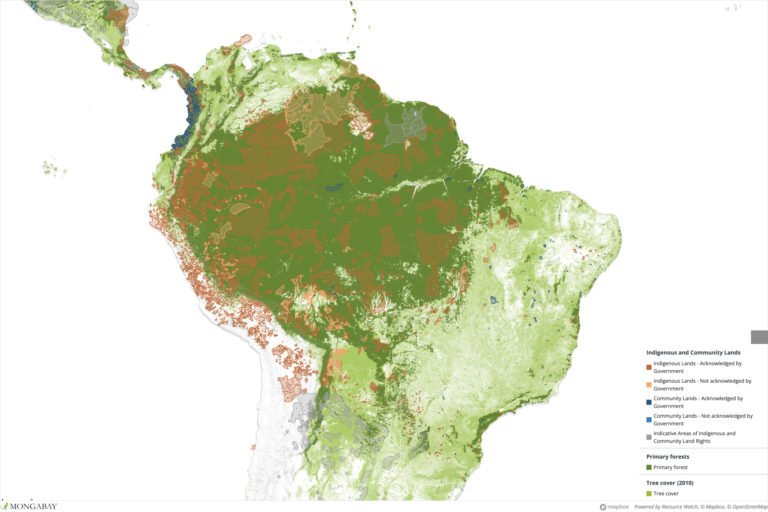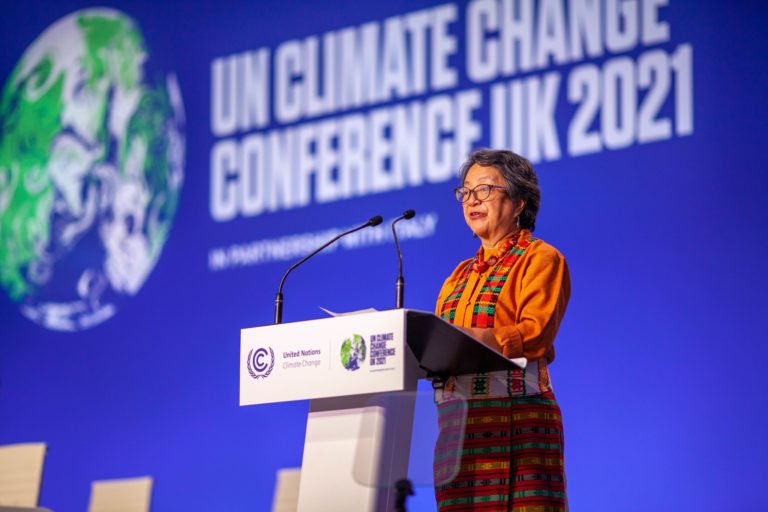- A new report by the Forest Declaration Assessment says that fulfilling the Paris Agreement won’t be possible without acknowledging and supporting the crucial role of Indigenous peoples and other local communities’ (IPLCs) in protecting lands.
- About 90% of IPLC lands are carbon sinks, say the report authors, Climate Focus and the World Resources Institute (WRI), which analyzed the IPLC lands in Brazil, Colombia, Mexico, and Peru.
- Each hectare of IPLC land sequesters an average of 30 metric tons of carbon every year, about twice as much as lands outside IPLC protection. This equates to about 30% of the four nation’s Paris Agreement targets.
- Countries should facilitate the titling of all IPLC lands, ensure consent to development projects, commit to protecting environmental defenders and make sure IPLCs are included in U.N. targets, says the report.
A new report by the Forest Declaration Assessment says that fulfilling the Paris Agreement won’t be possible without acknowledging and supporting the crucial role of Indigenous peoples and local communities’ (IPLCs) restored and protected lands.
Titled “Sink or swim”, the authors of the report, Climate Focus and the World Resources Institute (WRI), focus on the potential of IPLC lands in Brazil, Colombia, Mexico, and Peru to mitigate climate change. The report then peers into whether this potential is reflected in the respective countries’ climate-related policies and nationally determined contributions (NDCs) to meeting the Paris Agreement’s targets.
The release of the report comes days before the U.N. is set to release an assessment on climate mitigation with recommendations on how best to reduce carbon emissions and keep global temperatures below 1.5 degrees Celsius of pre-industrial levels.
Juan Carlos Altamirano, the WRI economist who led the report’s research calculating emissions sequestered in IPLC lands, told Mongabay that they had always been aware that IPLC lands were carbon sinks. But their investigation showed that this was the case in at least 90% of the research target areas.
In the four Latin American countries, research also revealed that each hectare (2.5 acres) of IPLC lands sequesters an average of 30 metric tons (33 tons) of carbon every year, about twice as much as lands outside IPLC protection. This equates to about 30% of the four countries’ Paris Agreement targets for 2030.
Without these contributions, states the report, other key economic sectors would have to pick up the slack to achieve the emission reduction targets promised. For example, Brazil and Colombia would have to retire 80% percent of their vehicle fleets to account for the loss of sequestration services their IPLC forests provide.
“Sometimes politicians or developers think that these lands are unproductive […] that raising cattle or cutting the trees for timber will make more sense from an economic point of view,” says Altamirano.
“But they don’t take into account all the ecosystem services that these lands are providing. And if you don’t take care of them, it will be even more difficult to do regular economic activities like agriculture or raising cattle.”

Cattle ranching, mining, and logging are major threats to these territories, says the report. A recent study found that most of the deforestation driven by commercial agriculture in all four countries is illegal, with the minimum extent of illegal mining at about 75% in Brazil, Colombia and Mexico.
“We are a stone in the shoe of development,” says Harol Rincon Ipuchima, Indigenous leader of the Maguta people in the Colombian Amazon and Climate Change and biodiversity coordinator at the Coordination of Indigenous Organizations of the Amazon Basin (COICA).
Ipuchima says that there is a need to diversify the economy, not based on soya or deforestation, sacrificing Mother Earth for economic development, but rather based on learning from how Indigenous communities have managed their territories.
“We have all the data to show that we are efficient and effective and that we should be taken into account,” says Ipuchima. “Everything that we are and everything that we have – our languages, our way to understand the world, our art – it’s the full package. And these elements come together to fulfill the standards to mitigate [climate change] and to protect biodiversity.”
Gaps in policy and governance
In South-East Asia, increased poverty and loss of livelihoods has played a role in pushing some IPLC community members towards unsustainable mining projects on their lands, or clearing forests and trees for cash crops.
According to researchers, this occurs as some people begin to lose land and their traditional relationship with nature, interact more with the market, and see financial incentives towards unsustainable activities as holding more sway than conservation. Researchers suggest securing and supporting IPLC traditional livelihoods and lands to prevent a slippery slope into unsustainable practices.

Yet unlike many parts of Africa and Asia, the report acknowledges that Brazil, Colombia, and Mexico are among the few countries in the world that have provided formal recognition of IPLC rights on most of their customary lands.
While Mexico, due to its history of agrarian reform, only needs to title the remaining 0.5% of IPLC lands according to the report, the other three countries have a longer way to go. The report’s authors call on governments to title all IPLC lands and the report details that titling processes should be sped up by dedicating sufficient resources to agencies responsible for land titling, providing funding to communities to cover their costs and simplifying titling procedures.
The role of IPLC land rights policies in the target countries, and the varying ways these can be applied, are also underlined. In Peru, the country’s superior courts have upheld the right of Indigenous people to exclude third parties from entering their lands, including those bearing mineral licenses.
Meanwhile, in both Mexico and Colombia, limits can still be placed on the scope of IPLC rights. For example, the state can grant mining licenses in titled IPLC lands without requiring communities’ consent.
“A lot of the countries have good laws on the books, but unfortunately, they often don’t implement their own laws, and that goes for the laws that protect Indigenous people’s lands,” says Darragh Conway, Climate Focus lead legal counsel who headed up the report’s policy aspects.

Conway says that they consistently see that when Indigenous and local communities stand up for their rights in the face of development projects that could destroy their forests and livelihoods, they are threatened with violence, criminalization, or legal intimidation.
According to Global Witness, Colombia leads in the world with 65 environmental defenders murdered in 2020, with Brazil and Mexico also having some of the highest global figures of 30 and 20 murders reported respectively. Internationally, over a third of all the fatal attacks reported target Indigenous people, with the figure going up to 50% in Mexico.
While all four countries have signed the Escazu Agreement—which includes provisions to protect the rights of environmental defenders in Latin America and the Caribbean—only Mexico has ratified it.
The report calls on the other three nations to follow suit and for all four governments to adopt legislation that ensures its commitments, such as strengthening law enforcement capacities to protect IPLCs from violence, are implemented.
Land rights on the international stage
The latest IPCC climate report released in February mentioned IPLC land rights 58 times, showcasing a shift in the way land rights are viewed as a climate change mitigation and adaptation solution.
Indigenous land rights have also taken center stage at negotiations on the U.N. Convention on Biological Diversity’s post-2020 Global Biodiversity Framework which concluded in Geneva on Tuesday. Indigenous caucus members and negotiators acknowledged that conserving biodiversity and reversing the species extinction crisis also entails securing IPLC land rights on a large scale.

Indigenous territories are estimated to contain 36% of the world’s remaining intact forest landscapes and 80% of the Earth’s remaining biodiversity.
The new global framework will be adopted at the U.N. biodiversity conference, COP 15, in Kunming, China, in May 2022. All four countries in the report have also signed the U.N. climate summit’s Glasgow Declaration on Forests and Land Use last November, committing to end forest loss and land degradation by 2030.
According to the report, placing the protection and empowerment of IPLCs lands at the heart of both the biodiversity framework and forest policy is crucial to having the Paris Agreement’s target within reach.
“How is it possible that governments, after having so much evidence based on Western modern science, still don’t understand the relevance [of Indigenous communities]?” said Guadalupe Yesenia Hernández Márquez, a Zapotec Indigenous leader from Oaxaca in Mexico who was part of the Indigenous people’s caucus at the U.N. biodiversity negotiations.
“We are requesting a role in the post-2020 [global biodiversity framework] because we have shown that we are needed,” said Márquez. “We want to continue conserving [biodiversity] as our lives depend directly on nature – something sacred to us.”
Banner image: Women, part of the Mam indigenous community, harvesting pine nuts in a forest in Cajolá, Quetzaltenango, to be sold later at a local market. Their work supports reforestation efforts and helps local families sustain themselves economically. Image courtesy of Sergio Izquierdo
Related listening from Mongabay podcast: We discuss several Indigenous-led conservation projects in the United States with Dr. Julie Thorstenson, a member of the Cheyenne River Sioux Tribe and director of the Native American Fish and Wildlife Society, as well as American science journalist and author Michelle Nijhuis. Listen here:
FEEDBACK: Use this form to send a message to the author of this post. If you want to post a public comment, you can do that at the bottom of the page.











